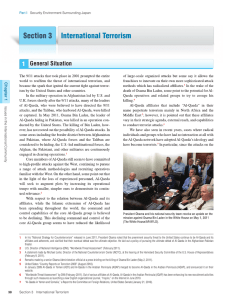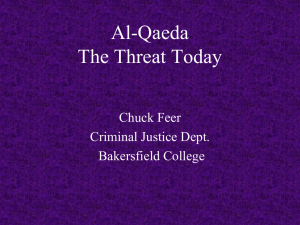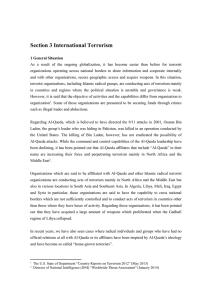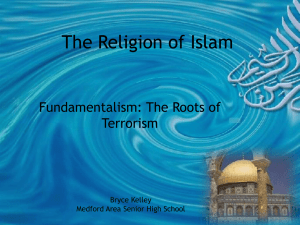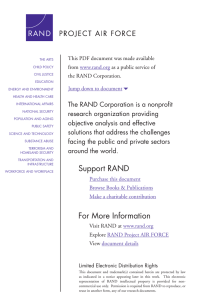3 International Terrorism General Situation
advertisement
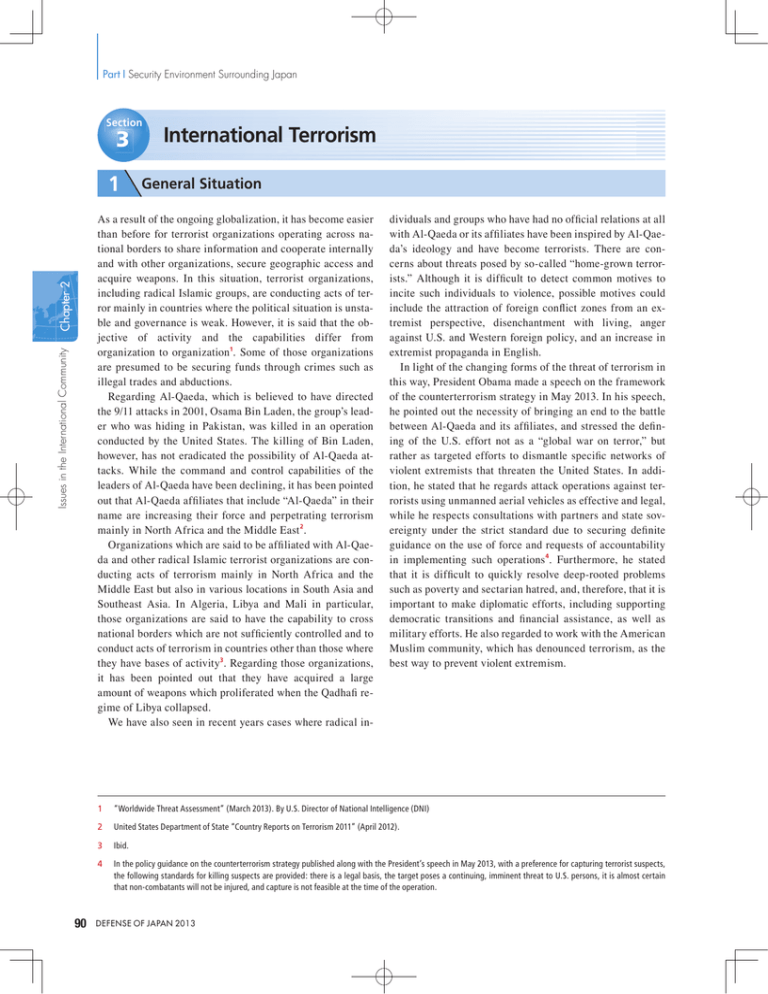
Part I Security Environment Surrounding Japan Section 3 1 International Terrorism General Situation Issues in the International Community Chapter 2 As a result of the ongoing globalization, it has become easier than before for terrorist organizations operating across national borders to share information and cooperate internally and with other organizations, secure geographic access and acquire weapons. In this situation, terrorist organizations, including radical Islamic groups, are conducting acts of terror mainly in countries where the political situation is unstable and governance is weak. However, it is said that the objective of activity and the capabilities differ from organization to organization1. Some of those organizations are presumed to be securing funds through crimes such as illegal trades and abductions. Regarding Al-Qaeda, which is believed to have directed the 9/11 attacks in 2001, Osama Bin Laden, the group’s leader who was hiding in Pakistan, was killed in an operation conducted by the United States. The killing of Bin Laden, however, has not eradicated the possibility of Al-Qaeda attacks. While the command and control capabilities of the leaders of Al-Qaeda have been declining, it has been pointed out that Al-Qaeda affiliates that include “Al-Qaeda” in their name are increasing their force and perpetrating terrorism mainly in North Africa and the Middle East 2 . Organizations which are said to be affiliated with Al-Qaeda and other radical Islamic terrorist organizations are conducting acts of terrorism mainly in North Africa and the Middle East but also in various locations in South Asia and Southeast Asia. In Algeria, Libya and Mali in particular, those organizations are said to have the capability to cross national borders which are not sufficiently controlled and to conduct acts of terrorism in countries other than those where they have bases of activity3. Regarding those organizations, it has been pointed out that they have acquired a large amount of weapons which proliferated when the Qadhafi regime of Libya collapsed. We have also seen in recent years cases where radical in- 90 dividuals and groups who have had no official relations at all with Al-Qaeda or its affiliates have been inspired by Al-Qaeda’s ideology and have become terrorists. There are concerns about threats posed by so-called “home-grown terrorists.” Although it is difficult to detect common motives to incite such individuals to violence, possible motives could include the attraction of foreign confl ict zones from an extremist perspective, disenchantment with living, anger against U.S. and Western foreign policy, and an increase in extremist propaganda in English. In light of the changing forms of the threat of terrorism in this way, President Obama made a speech on the framework of the counterterrorism strategy in May 2013. In his speech, he pointed out the necessity of bringing an end to the battle between Al-Qaeda and its affiliates, and stressed the defining of the U.S. effort not as a “global war on terror,” but rather as targeted efforts to dismantle specific networks of violent extremists that threaten the United States. In addition, he stated that he regards attack operations against terrorists using unmanned aerial vehicles as effective and legal, while he respects consultations with partners and state sovereignty under the strict standard due to securing definite guidance on the use of force and requests of accountability in implementing such operations 4 . Furthermore, he stated that it is difficult to quickly resolve deep-rooted problems such as poverty and sectarian hatred, and, therefore, that it is important to make diplomatic efforts, including supporting democratic transitions and financial assistance, as well as military efforts. He also regarded to work with the American Muslim community, which has denounced terrorism, as the best way to prevent violent extremism. 1 “Worldwide Threat Assessment” (March 2013). By U.S. Director of National Intelligence (DNI) 2 United States Department of State “Country Reports on Terrorism 2011” (April 2012). 3 Ibid. 4 In the policy guidance on the counterterrorism strategy published along with the President’s speech in May 2013, with a preference for capturing terrorist suspects, the following standards for killing suspects are provided: there is a legal basis, the target poses a continuing, imminent threat to U.S. persons, it is almost certain that non-combatants will not be injured, and capture is not feasible at the time of the operation. DEFENSE OF JAPAN 2013 Section 3 International Terrorism Fig. I-2-3-1 Major Terrorist Groups Based in Africa and the Middle East Regions Al-Qa'ida in the Islamic Maghreb (AQIM) Al-Qa'ida in Iraq (AQI) Nusra Front Hizballah Syria Hamas Algeria Libya Lebanon Taliban Al-Qa'ida Afghanistan Iraq Palestine Pakistan Chapter 2 Tenrik-e Taliban Pakistan Mali Yemen Issues in the International Community Nigeria Somalia Al-Qaeda in the Arabian Peninsula (AQAP) Ansar al-Dine Boko Haram Al-Qaeda-related groups Groups whose relation with Al-Qaeda has been pointed out Other Islamic radical terrorist groups Nations where terrorist groups are believed to have their bases 2 Al-Shabaab The United States Geological Survey: GTOPO30; and the United States National Oceanic and Atmospheric Administration: ETOPO1 Source: Created based on The Worldwide Threat Assessment (March 12, 2013) Trends Concerning Terrorism Around the World In Libya, a radical Islamic group carried out an attack on the U.S. consulate general in Benghazi in September 2012, killing four Americans, including the ambassador. In Mali, Ansar al-Dine, which is said to have effective control over the northern part of the country and to be affiliated with Al-Qaeda, declared its intention to carry out retaliatory terrorist attacks in response to an attack by a French force deployed at the request of the transitional Mali government. Thus, the threat of terrorism is persisting. In Algeria, a radical Islamic group reportedly broke away from Al-Qaeda in the Islamic Maghreb, which has engaged in abductions targeting mainly Algerians and Westerners, and carried out an attack on a natural gas plant in January 2013, resulting in the deaths of many people, including 10 Japanese nationals. As a reason for the terrorist act, this group cited the permission given by Algeria for the passage of a French force through its airspace on the occasion of the military intervention in Mali1. Moreover, the group’s members who actually carried out the attack are presumed to have acquired weapons in neighboring countries and crossed national borders into Algeria. In Iraq, even after the withdrawal of the U.S. forces in December 2011, though the state of public order remained relatively undisturbed, acts of terrorism targeting high-level government officials, foreigners, security authorities, and others have sporadically occurred, and groups such as Al-Qaeda in Iraq claimed responsibility. Thus, Iraq continues to face the threat of terrorism. Terrorist attacks have recently been on the rise targeted at diplomatic delegates and other groups in Yemen. In October 2010, some explosive materials were discovered in multiple air 1 See Section 4 Defense of Japan 91 Part I Security Environment Surrounding Japan Issues in the International Community Chapter 2 cargoes bound for the U.S., which were revealed to have originated in Yemen. It is thought that these attacks were conducted by groups affiliated with Al-Qaeda. In addition, it has been pointed out that activities by Al-Qaeda in the Arabian Peninsula (AQAP) are continuing2. In Somalia, the presidential election was held in September 2012. Although a new cabinet was inaugurated in November of the same year, battles still continued between Al-Shabaab, which is said to be affiliated with Al-Qaeda and which has effective control over some parts of the country, and the government forces and the African Union Mission in Somalia (AMISOM). Al-Shabaab withdrew from many of its positions due to attacks by the government forces, but it continued abductions of foreigners and acts of terrorism against the government and AMISOM3. In Nigeria, Boko Haram, which aims to build an Islamic nation, has stepped up its activities since 2010, carrying out acts of terrorism repeatedly in retaliation against a crackdown by po- 92 lice and other authorities. In addition, in August 2011, Boko Haram claimed responsibility for a suicide bombing targeting a United Nations building in the Nigerian capital of Abuja. South Asia has long been suffering frequent terrorist attacks. In particular, Pakistan has experienced a number of terrorist attacks targeting religious facilities and government organizations masterminded by Tahrike Taliban Pakistan (TTP) or Al-Qaeda. In Southeast Asia, some progress has been made in countering terrorist organizations. In the Philippines, it is pointed out that terrorist organizations such as the Islamic extremist Abu Sayyaf Group (ASG), which have been the source of the biggest domestic public security concern, have now significantly weakened. (See Fig. 1-2-3-1) 2 “Worldwide Threat Assessment” by DNI (January 2013) reports bombing attempts in February 2012 believed to be the work of AQAP and combat between AlQaeda-affiliated militants and government troops in March 2012. 3 Leaders of Al-Shabaab and Al-Qaeda have been reported to be united in February 2012. DEFENSE OF JAPAN 2013
